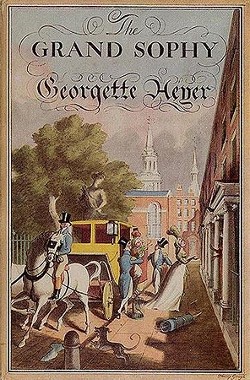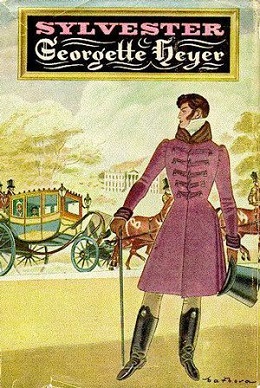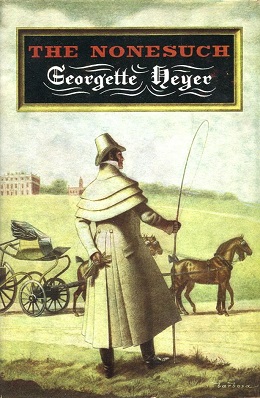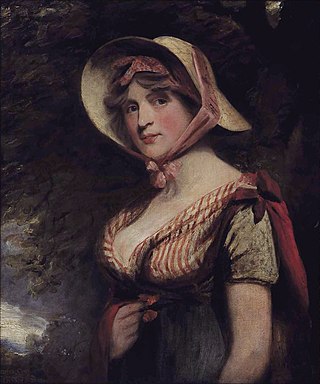
Frederica of Mecklenburg-Strelitz was Queen of Hanover from 20 June 1837 until her death in 1841 as the wife of King Ernest Augustus. She was a German princess who married successively Prince Louis Charles of Prussia, Prince Frederick William of Solms-Braunfels, and her first cousin Ernest Augustus. Through her 1815 marriage to Ernest, then Duke of Cumberland, Frederica became a British princess and Duchess of Cumberland. Ernest was the fifth son and eighth child of Queen Charlotte and King George III of the United Kingdom, Frederica's paternal aunt and her husband.

Lady Susan is an epistolary novella by Jane Austen, possibly written in 1794 but not published until 1871. This early complete work, which the author never submitted for publication, describes the schemes of the title character.

These Old Shades (1926) is a historical romance written by British novelist Georgette Heyer. The novel is set around 1755: Heyer refers to the Duke of Avon's participation in the 1745 uprising as ten years previous; in addition the Prince of Condé is said to be about 20 years old. However, she also refers to Madame de Pompadour as actively involved with Louis XV, whereas her relationship with the King ended at about 1750.

Devil's Cub is a Georgian romance novel written by Georgette Heyer. Set in 1780, it is the sequel to These Old Shades (1926). The book was published in 1932, and has not been out of print since. It is one of Heyer's most popular novels.

Friday's Child is a novel written by Georgette Heyer in 1944. It is generally considered one of Miss Heyer's best Regency romances, and was reportedly the favourite of the author herself. Heyer retained only a single fan letter, which was from a Romanian political prisoner who kept herself and her fellow prisoners sane for twelve years by telling and retelling the plot of Friday's Child.

The Grand Sophy is a Regency romance novel by Georgette Heyer. It was first published in 1950 by Heinemann in the UK and Putnam in the U.S. Sales were brisk. Heinemann reported that in Australia it sold forty thousand copies in its first five months. There was also a Book Club edition in 1951.

Sylvester, or the Wicked Uncle is a Regency romance novel by Georgette Heyer. First published by Heinemann, London and Putnam, New York in 1957, it is the story of intelligent and desperate Phoebe who ends up marrying the man she has run away from home to avoid, and whom she has caricatured as the villain in her novel. The book features gentle mockery of the Gothic novel genre and also features Heyer's characteristic strong heroine, with a desire for independence, who marries on her own terms. The story is set in 1817-1818.

Bath Tangle is a Regency romance novel by Georgette Heyer. The story is set in 1816.

Sarah Sophia Child Villiers, Countess of Jersey, born Lady Sarah Fane, was an English noblewoman and banker, and through her marriage a member of the Villiers family.

Cotillion is a Regency romance novel by Georgette Heyer published in 1952. It is one of the most light-hearted of Heyer's romances, avoiding the mystery, intrigue, and sensational events present in many of her novels. The story is set in 1816.

The Black Moth (1921) is a Georgian era romance novel by the British author Georgette Heyer, set around 1751. The Black Moth was Heyer's debut novel, published when Heyer was nineteen. It was a commercial success.

The Talisman Ring is a historical romance novel by Georgette Heyer, first published in 1936. Set in 1793, in the Georgian era, the action takes place in Sussex, where Heyer then lived.

An Infamous Army is a novel by Georgette Heyer. In this novel Heyer combines her penchant for meticulously researched historical novels with her more popular period romances. So in addition to being a Regency romance, it is one of the most historically accurate and vividly narrated descriptions of the Battle of Waterloo. An Infamous Army completes the sequence begun with These Old Shades and is also a sequel to Regency Buck.

The Corinthian is a regency novel by Georgette Heyer.

Faro's Daughter is a Georgian romance novel by Georgette Heyer that was first published in 1941 by Heinemann in the UK and in the US by Doubleday in 1942. The story's focus is on the misfortunes of an aunt and niece trying to run a gambling house for the upper classes.

The Nonesuch is a Regency romance novel by Georgette Heyer. The story is set in 1816/1817.

A Civil Contract is a Regency romance novel by Georgette Heyer, first published in 1961. Set in 1814–1815, it is also a historical novel and follows the general pattern of storytelling of Heyer's other novels. The romantic plot centers on a viscount who reluctantly enters a marriage of convenience with a wealthy merchant's daughter.

Charity Girl is a Regency romance novel by Georgette Heyer, first published in 1970.

Louisa Manners Tollemache, 7th Countess of Dysart was a peer in the Scottish peerage in a flourishing family. Her father held considerable estates in England largely due to the two marriages of Elizabeth Maitland, Duchess of Lauderdale, earlier Tollemache, née Elizabeth Murray. Her elder brothers left no surviving issue on their deaths which enabled her to enjoy and help to pass on to her descendants the key family settlement properties: Helmingham Hall and Ham House in England.



















